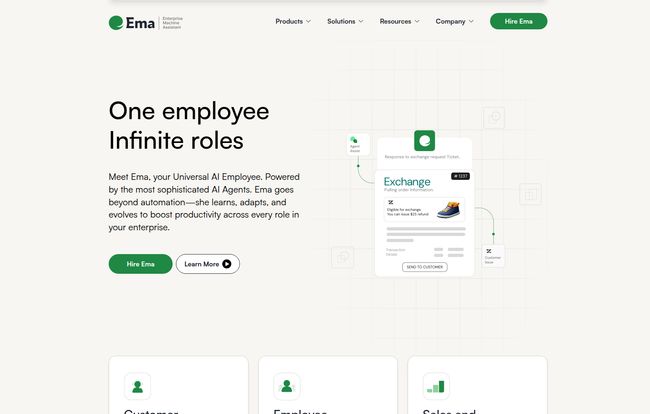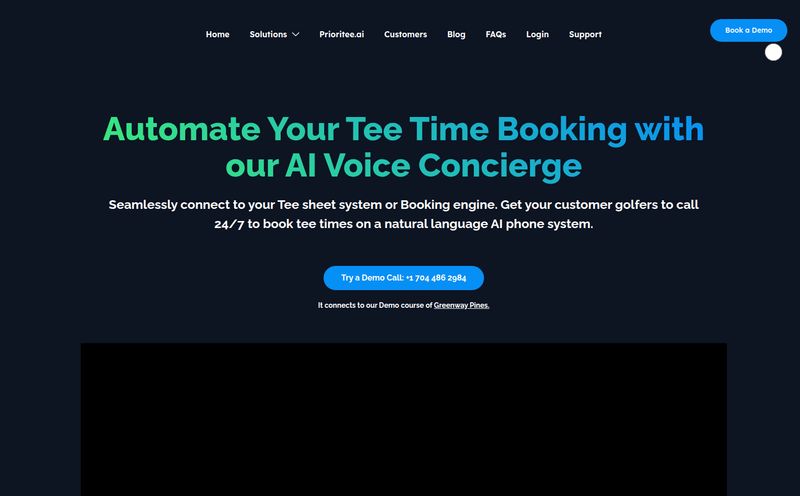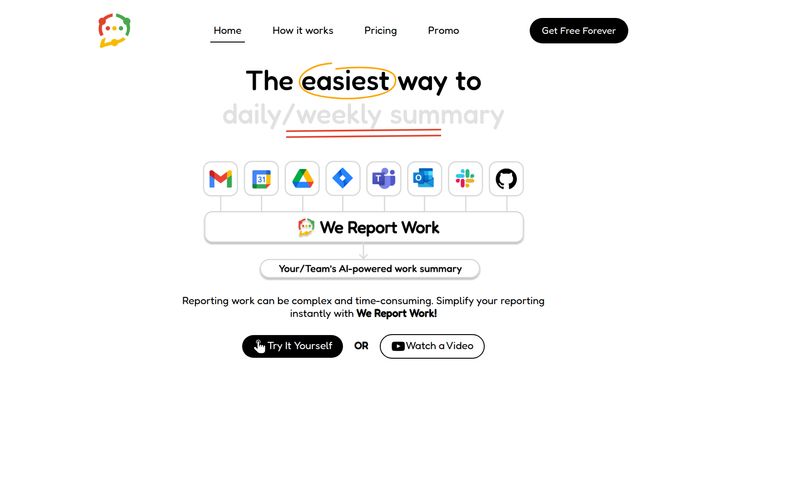I’ve been in the digital marketing and SEO space for what feels like a lifetime. I've seen trends come and go faster than fashion styles. Remember when every business had to have an app? Or when chatbots were going to solve all our customer service woes overnight? Yeah. Me too. Each wave of tech brings a tidal wave of hype, and honestly, it can get exhausting.
So when I first heard about Ema, branding itself as a "Universal AI Employee," my knee-jerk reaction was a healthy dose of skepticism. An AI employee? Not an assistant, not a tool, but an employee. That’s a pretty gutsy way to frame your product. It’s a bold claim. A really bold claim. But in a world saturated with single-function AI tools that promise the moon and deliver a small, slightly dusty rock, maybe bold is what we need.
What is Ema, Really? More Than Just Another Acronym
Let's get past the marketing speak for a second. Ema, which stands for Enterprise AI Assistant, positions itself as an AI agent capable of taking on entire roles within a company. We're not just talking about answering support tickets. The examples they give are wildy specific: a customer support rep, a data scientist, a proposal manager, even a pharmacist’s assistant. The idea is to automate complex, multi-step processes and workflows, freeing up actual human beings (like you and me) to focus on work that requires strategy, creativity, or, you know, a soul.
It's a shift in thinking from "using an AI tool" to "delegating to an AI team member." I have to admit, that reframing is clever. It immediately makes you think about outcomes instead of just features.
The Three Pillars: Simple, Trusted, and Accurate
Ema's entire pitch seems to hang on three core promises. Let's break them down because if they can't nail these, the whole "AI Employee" thing falls apart.
Is It Genuinely Simple to Deploy?
The biggest hurdle for any enterprise software is the implementation nightmare. We've all been there. Months of integration, endless meetings, and a final product that only half-works. Ema tries to sidestep this with a library of pre-built AI agents. The idea is that you can get started almost immediately by deploying an AI that's already trained for a specific function. This lowers the barrier to entry significantly. Of course, the real test is how much customization is needed to fit your specific, weirdly unique business processes. But starting from a template beats starting from scratch any day of the week.
A Serious Approach to Trust and Security
This one is huge. In the enterprise world, you can't just plug your company's private data into some random AI and hope for the best. It's a recipe for disaster. Ema seems to understand this, putting a heavy emphasis on their compliance, security, and data privacy protocols. For any C-suite executive reading this, that's probably the first thing you'd look for. Without it, the conversation is a non-starter.
The Quest for Accuracy with EmaFusion™
Here’s where things get technically interesting. Ema’s secret sauce appears to be a technology they call EmaFusion™. Instead of relying on a single Large Language Model (LLM) like GPT-4 or Claude 3, EmaFusion intelligently routes tasks to a whole network of over 100 different models.
Think of it like managing a team of human experts. You wouldn't ask your brilliant creative writer to build a complex financial model. You'd give that to the numbers whiz. EmaFusion does the same thing, but with AIs. It sends the task to the model best suited for the job, whether it requires logic, creativity, data analysis, or summarization. This multi-LLM approach is a smart way to combat the classic AI weakness of being a jack-of-all-trades but a master of none. It dramatically increases the chances of getting a truly accurate and relevant result.

Visit Ema
The Engine Room: Key Features That Actually Matter
Okay, so the high-level concept is compelling. But what are the actual gears turning inside this machine? A few features stand out.
EmaFusion™: The Multi-LLM Command Center
I touched on this, but it's worth its own section. The AI space is not a one-horse race. Some models are better at code, some at poetry, some at factual recall. By building a system that can leverage the best of the best, Ema is future-proofing its platform and optimizing for quality. It’s a fundamentally better architecture than tying your wagon to a single LLM provider. This is the kind of nuanced engineering that signals a deep understanding of the AI landscape.
Generative Workflow and Document Intelligence
This is where the automation gets real. Ema’s Generative Workflow Engine allows it to connect different tasks together. It's not just doing one thing; it's completing an entire process. For example, a new sales lead comes in. Ema could potentially read the inquiry, pull relevant data from your CRM, analyze the lead's company website, draft a personalized outreach email, and schedule a follow-up task. That’s not just a feature; that’s a full-time sales development rep's morning.
Combine that with Document Intelligence—the ability to read, understand, and extract information from PDFs, reports, and spreadsheets—and you have something pretty powerful. Imagine an AI that can actually read all 150 pages of that industry report and give you the three paragraphs that matter to you. Yes please.
Pre-built Personas: Hitting the Ground Running
The list of roles Ema can supposedly fill is impressive. From customer support to compliance analysis. This is where the platform could genuinely shine for businesses. Instead of spending six months building and training a custom AI model, you could deploy Ema's "Compliance Analyst" persona to start monitoring for regulatory issues right away. It makes the technology much more accessible and provides a faster path to ROI. It's a practical solution to a complex problem.
The Million-Dollar Question: What's the Price Tag?
Alright, let's address the elephant in the room. You go to their website, you're getting excited, you're imagining all the tedious tasks you can finally offload... and then you look for the pricing page. And you find... a 404 error. Or just... nothing.
Don't panic. This is actually pretty standard for high-level enterprise software. It's not a bug, it's a feature. The lack of a public pricing page almost always means one thing: "it depends." The cost will likely be customized based on the scale of your organization, the number of AI "employees" you want to hire, the complexity of the workflows, and the level of support you need. This isn't a $20/month subscription for a solopreneur. This is a strategic investment for a medium to large enterprise, and the price will reflect that. You'll need to talk to their sales team and get a custom quote. So, while we can't give you a number, we can tell you to expect an enterprise-level conversation.
A Balanced Perspective: The Good and The Could-Be-Better
No tool is perfect. As an experienced professional, I know to look for the trade-offs. On one hand, the potential to automate soul-crushing, repetitive work is immense. It could free up teams to be more innovative and strategic, which is the holy grail of business operations. The EmaFusion tech is genuinely impressive, and the focus on security is reassuring.
However, let's be realistic. This isn't a "set it and forget it" solution. An AI employee, just like a human one, will require management and oversight. You'll need someone to monitor its performance, fine-tune its workflows, and handle exceptions. There's also the potential for significant upfront customization to make it work just right for your business, which means an investment of both time and money. It’s a powerful tool, not a magic wand.
Final Thoughts: Is It Time to Hire Your First AI?
After looking at what Ema offers, my initial skepticism has softened into cautious optimism. The concept of a "Universal AI Employee" is more than just clever marketing; it represents a fundamental shift in how we approach automation. It’s moving beyond simple task-bots and into the realm of integrated, role-based AI agents.
Is Ema the one to pull it off? It seems to have the right ingredients: a smart multi-LLM architecture, a focus on enterprise-grade security, and a practical approach with pre-built personas. It won't be for everyone—early-stage startups and small businesses should probably look elsewhere. But for a larger organization drowning in operational overhead and repetitive grunt work, Ema could be a genuinely transformative solution. It might just be time to start drafting an offer letter for your first AI employee.
Frequently Asked Questions
- 1. What exactly is Ema?
- Ema is an enterprise AI platform that offers a "Universal AI Employee." It's an advanced AI agent designed to automate entire job roles and complex workflows across different departments, like customer service, HR, and marketing, rather than just performing single tasks.
- 2. What makes Ema different from other AI tools like ChatGPT?
- The key differentiator is its EmaFusion™ technology and its "AI Employee" model. While tools like ChatGPT are general-purpose assistants, Ema uses a network of over 100+ specialized LLMs to pick the best one for each specific task, aiming for higher accuracy. Its focus is on automating entire business processes and roles within an enterprise environment.
- 3. Is Ema a good fit for small businesses?
- Based on its feature set, security focus, and lack of public pricing, Ema is primarily targeted at medium to large enterprises. Small businesses might find it too complex or costly for their needs, as it's built for large-scale operational automation.
- 4. How does Ema handle data privacy and security?
- Ema places a strong emphasis on enterprise-grade trust and security. It's designed with compliance and data protection in mind to meet the strict requirements of large organizations handling sensitive customer and company information.
- 5. How much does Ema cost?
- Ema does not have public pricing information on its website. This is common for enterprise software, and pricing is typically provided on a custom-quote basis after consulting with their sales team to assess your company's specific needs and scale.



